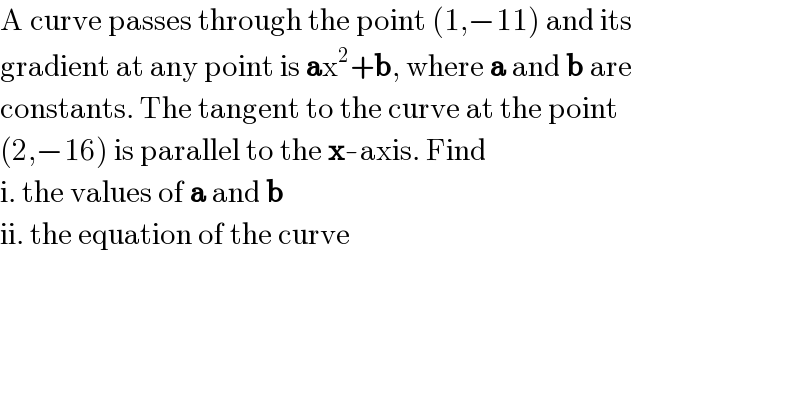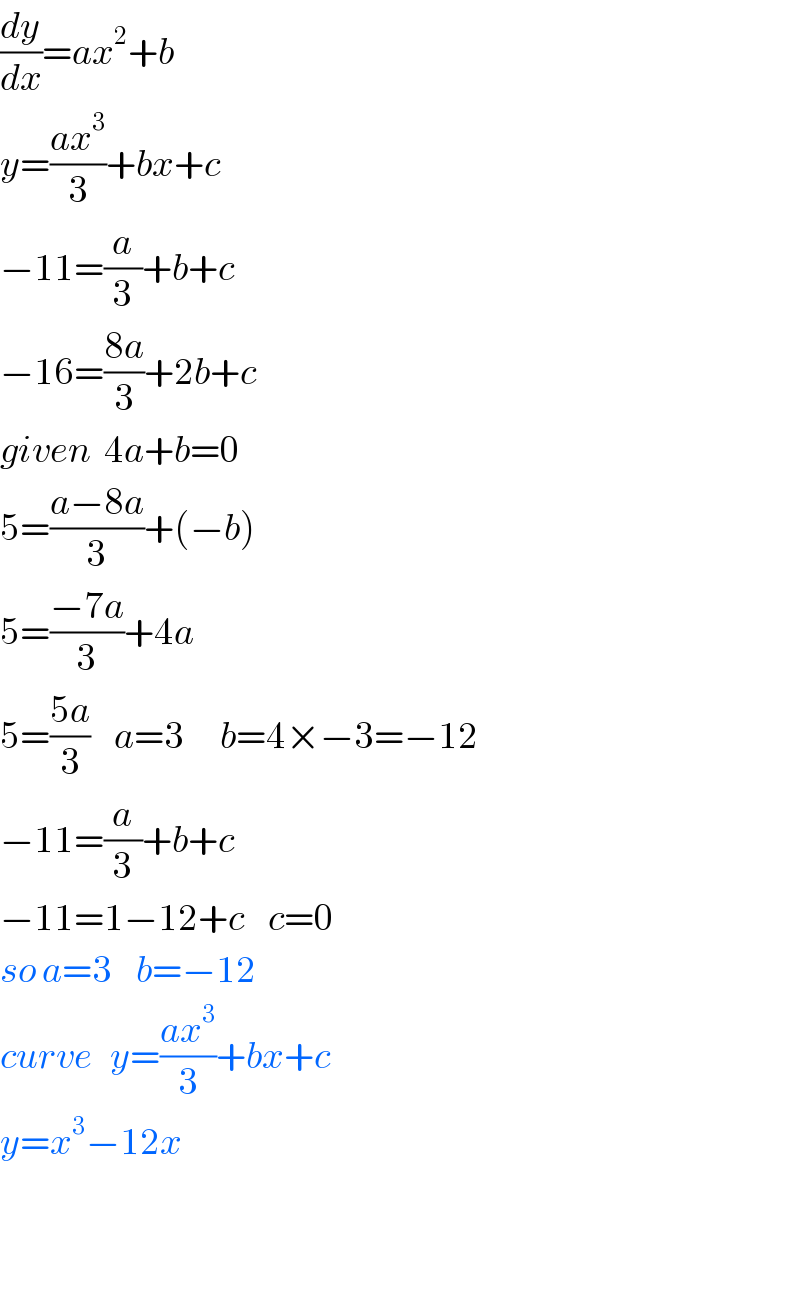
Question Number 43923 by pieroo last updated on 17/Sep/18

$$\mathrm{A}\:\mathrm{curve}\:\mathrm{passes}\:\mathrm{through}\:\mathrm{the}\:\mathrm{point}\:\left(\mathrm{1},−\mathrm{11}\right)\:\mathrm{and}\:\mathrm{its} \\ $$$$\mathrm{gradient}\:\mathrm{at}\:\mathrm{any}\:\mathrm{point}\:\mathrm{is}\:\boldsymbol{\mathrm{a}}\mathrm{x}^{\mathrm{2}} +\boldsymbol{\mathrm{b}},\:\mathrm{where}\:\boldsymbol{\mathrm{a}}\:\mathrm{and}\:\boldsymbol{\mathrm{b}}\:\mathrm{are} \\ $$$$\mathrm{constants}.\:\mathrm{The}\:\mathrm{tangent}\:\mathrm{to}\:\mathrm{the}\:\mathrm{curve}\:\mathrm{at}\:\mathrm{the}\:\mathrm{point} \\ $$$$\left(\mathrm{2},−\mathrm{16}\right)\:\mathrm{is}\:\mathrm{parallel}\:\mathrm{to}\:\mathrm{the}\:\boldsymbol{\mathrm{x}}-\mathrm{axis}.\:\mathrm{Find} \\ $$$$\mathrm{i}.\:\mathrm{the}\:\mathrm{values}\:\mathrm{of}\:\boldsymbol{\mathrm{a}}\:\mathrm{and}\:\boldsymbol{\mathrm{b}} \\ $$$$\mathrm{ii}.\:\mathrm{the}\:\mathrm{equation}\:\mathrm{of}\:\mathrm{the}\:\mathrm{curve} \\ $$
Answered by tanmay.chaudhury50@gmail.com last updated on 18/Sep/18

$$\frac{{dy}}{{dx}}={ax}^{\mathrm{2}} +{b}\: \\ $$$${y}=\frac{{ax}^{\mathrm{3}} }{\mathrm{3}}+{bx}+{c} \\ $$$$−\mathrm{11}=\frac{{a}}{\mathrm{3}}+{b}+{c} \\ $$$$−\mathrm{16}=\frac{\mathrm{8}{a}}{\mathrm{3}}+\mathrm{2}{b}+{c} \\ $$$${given}\:\:\mathrm{4}{a}+{b}=\mathrm{0} \\ $$$$\mathrm{5}=\frac{{a}−\mathrm{8}{a}}{\mathrm{3}}+\left(−{b}\right) \\ $$$$\mathrm{5}=\frac{−\mathrm{7}{a}}{\mathrm{3}}+\mathrm{4}{a} \\ $$$$\mathrm{5}=\frac{\mathrm{5}{a}}{\mathrm{3}}\:\:\:\:{a}=\mathrm{3}\:\:\:\:\:\:{b}=\mathrm{4}×−\mathrm{3}=−\mathrm{12} \\ $$$$−\mathrm{11}=\frac{{a}}{\mathrm{3}}+{b}+{c} \\ $$$$−\mathrm{11}=\mathrm{1}−\mathrm{12}+{c}\:\:\:\:{c}=\mathrm{0} \\ $$$${so}\:{a}=\mathrm{3}\:\:\:\:{b}=−\mathrm{12} \\ $$$${curve}\:\:\:{y}=\frac{{ax}^{\mathrm{3}} }{\mathrm{3}}+{bx}+{c} \\ $$$${y}={x}^{\mathrm{3}} −\mathrm{12}{x} \\ $$$$ \\ $$$$ \\ $$
Commented by pieroo last updated on 18/Sep/18

$$\mathrm{thanks}\:\mathrm{sir} \\ $$
